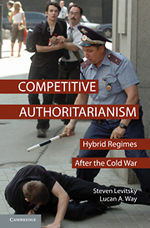
Competitive Authoritarianism: Hybrid Regimes After the Cold War
Competitive authoritarian regimes – in which autocrats submit to meaningful multiparty elections but engage in serious democratic abuse – proliferated in the post–Cold War era. Based on a detailed study of 35 cases in Africa, Asia, Latin America, and post-communist Eurasia, this book explores the fate of competitive authoritarian regimes between 1990 and 2008. It finds that where social, economic, and technocratic ties to the West were extensive, as in Eastern Europe and the Americas, the external cost of abuse led incumbents to cede power rather than crack down, which led to democratization. Where ties to the West were limited, external democratizing pressure was weaker and countries rarely democratized. In these cases, regime outcomes hinged on the character of state and ruling party organizations. Where incumbents possessed developed and cohesive coercive party structures, they could thwart opposition challenges, and competitive authoritarian regimes survived; where incumbents lacked such organizational tools, regimes were unstable but rarely democratized.
Part I. Introduction and Theory: 1. Introduction; 2. Explaining competitive authoritarian regime trajectories: international linkage and the organizational power of incumbents;
Part II. High Linkage and Democratization: Eastern Europe and the Americas: 3. Linkage, leverage, and democratization in Eastern Europe; 4. Linkage, leverage, and democratization in Latin America and the Caribbean;
Part III. The Dynamics of Competitive Authoritarianism in Low Linkage Regions: The Former Soviet Union, Africa, and Asia: 5. The evolution of post-Soviet competitive authoritarianism; 6. Africa: transitions without democratization; 7. Diverging outcomes in Asia; 8. Conclusion;
Appendix. Measuring competitive authoritarianism and authoritarian stability.